







 |
 |
 |
 |
 |
 |
 |
 |


 annual 22
FF334
FF337
annual 23
FF343
did you notice?
FF347
FF350
FF351
FF352
FF353
annual 22
FF334
FF337
annual 23
FF343
did you notice?
FF347
FF350
FF351
FF352
FF353

Summary
The legendary Steve Englehart covered the end of FF continuity (FF322-333). The legendary Walt Simonson then celebrated its end in a big way (FF334-355): every issue was about the end of continuity. We now move fully into the Franklinverse, the Marvel Universe unconsciously controlled by Franklin Richards.
FF annual 22 is the next FF issue from FF 333. Here we see the clone team in action.

How we know these are the clones
The clone team has several distinguishing features:
The Ben Reilly principle
Here the clone team never says it is the clone team. As far as anybody
can tell they now believe they are the original. After all, they badly
wanted to win the battle in FF 333, so if we follow their dreams we
would see that yes, they won, and they were the real team. We could call
this the Ben Reilly principle: Ben Reilly not only believed he was the
real Spider-Man, he had the medical tests to prove it (in the Spider-Man
clone saga). What somebody sincerely believes is not proof.
Two years after this issue we see the same situation with Lyja. For years we thought we were seeing Alicia in the stories, but it as revealed to be the Skrull, Lyja. But Lyja gave no clues and wanted to live as the real Alicia, complete with her past and memories. Years later we saw the same situation again with Secret Invasion: we had followed various characters for years, believing them to be the originals, and they looked and acted the part. But then we found they were not.
The following years
Looking back, 50 years laterThis might be a good time to step back and look at the FF
history, clones and all. These are the favorite runs according to a
cross section of fans who buy the comics in 2014 (according to 5717
voters on "Comic Book Resources", cross posted by "Rheged"): Among older fans, Stan Lee and Jack Kirby are nearly always
first. I was shocked they came third in this modern list: kids today!!! My own listMy own list is different from most people's, because:
1. Lee and Kirby And the post 333 issues: 9. Anything with Steve Rude art - basically 2 issues After this I'm likely to change my mind as I haven't read them in such depth |
In various interviews (in Modern Masters, Comic Creators, and in emails) Simonson explains why he chose these stories: they reflect the world around him: the corporation (time variance authority, commercialism) and his views on old comics (shiny Doom). In emails, Simonson said he never intended to have his run celebrate the end of FF continuity, but he concluded,
"All that being said, stories have
their own lives. You create them and set them free, and after
that, they evolve as they will, sometimes developing independently
of their creators' thoughts."
The new zeitgeist: inward
looking
In the 1960s, all the comic creators had broad experience: at the
very least, they could write romance and war comics as well as
just superheroes. The best of them - people like Jack Kirby and
Jim Steranko - had a wealth of real world experience. The ideas
that swirled around them were the whole world. They lived in the
zeitgeist of the times. This was true to a large extent in the 1970s as well, but as time
went on and the superheroes became entrenched, more and more of
the creative teams had no experience outside of superheroes. Their
zeitgeist - the spirit of the age as far as they were concerned -
was the superhero comics they grew up with. Their reference points
were all cut off from reality. For the corporate higher ups it was even worse. In the 1960s
they had to care about attracting new readers. But success meant
merchandising, and a fan base. Most of the money now came from
milking existing brands and existing fans. The management, like
the writers, became inward looking.
Reflecting the American
zeitgeist
This period, 1989-91, saw nations change due to the end of the
cold war. As a result America felt more confidence in using its
military might (e.g. in Gulf War I, 1990). This period also saw a
global recession (1990-1993) and the both of the Internet, leading
to a later investment bubble (crashing in 1999). All this was
reflected in Marvel comics, which was sometimes ahead of the
curve: seeing its own bubble in 1992 and filing for bankruptcy in
1996.
Simonson entered in the middle of yet another enforced cross over. This clearly made no sense, so he had fun with it, pitting the characters against enemies who were obviously inferior. Every cover is a variation on the title "Alone against the deadliest villains in the universe" and the team says "you're kidding, right?" While intended as a joke, this reflected the reality: swapping enemies for the sake of variety (or any other intrusive cross over) makes no story sense. When a story is so obviously contrived then you can't take it seriously any more.
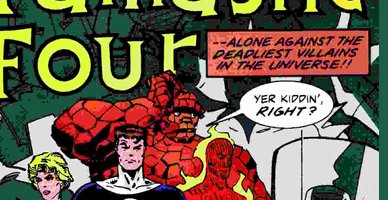
The first thing the clone team does is record new retina scans.
Because clones, although they share the same DNA, have different
retinas.

Objections to the clone retina scan theory
Maybe the virus deleted the old data?
On the page after making the new scans Reed implies that, if the memory
banks were connected, normal identification would be easy. So the memory
banks must still contain reliable IDs. Reliable IDs are based on
retinal scans (see FF 265)
Maybe the data was lost some other way?
There is no record of this in the comics. It is also very unlikely: the FF share their identification data with the Avengers
How did they get in?
How could the cpone team get past the retina scans in the first place? The
wizard's computer virus allowed unauthorized people to get in: see FF
326.
More evidence
A different Johnny
Johnny does not recognise the retinal scan device. The original Johnny probably would have known about this already.
A different Reed
Reed says they need to look into a seperate device in order to use it.
But the original Reed aready had technology for scanning eyes without
the subject having to do anything. This all points to them being
different people.
"Baloney!" - the different Ben
Ben's comment is a reminder of his "Bah" line when in rocky form. (His
language is more restrained because he's happier when in regular human
form.) The real Ben hadn't come out with outbursts like that for years.
A different Sue
Note that Sue just tags along, and only talks about Reed and Reed's
needs. She is playing nursemaid, just like the clone Sue, but unlike the
dynamic Sue of recent issues.
Alicia and Skrulls
The clone team tried to follow the original team's adventures. But they
could not find any Skrulls. Or could they? The Skrulls this time would
be ready for them. Later we find that this Alicia is a Skrull. Instead
of impersonating the FF, as they did in issue 3, the Skrulls are
impersonating Alicia. They will claim that this began when Ben
disappeared in Secret Wars, but that contradicts the evidence: Alicia's
probems with Ben stem from before that (see the discussion of FF 275 for
details). Besides, this is a different Alicia: the SKrull Alicia lacks
the skill to create representative art, but the real Alicia was seen
doing that just recently. (For details, see the page on the dfifferent
FF.) It is more likely that Alicia was swapped when the clone team went
looking for Skrulls, but they did not want to draw attention to
themselves being the clone team, so gave a different story to Marvel.
What most worries the team
The team spends weeks gauging people's reaction to the clone team. If they are the clone team no wonder they're worried!

The nest story is about all-powerful beings (good metaphors for Marvel editors) who prevent the world from moving into the future. It ends with Galactus, using the editor's authority - sorry, the ultimate nullifier - to turn everything back to the way it was.
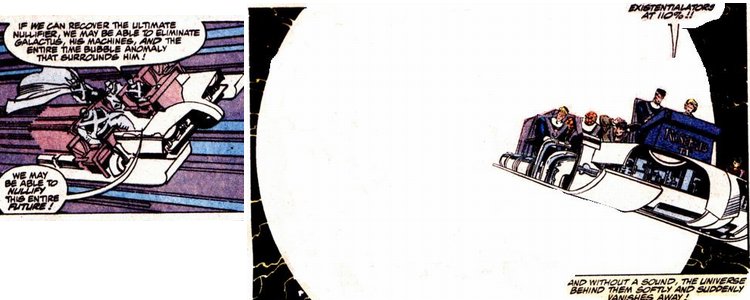
Incidentally, this grand editorial reset is one of the best non-canonical FF stories ever. A real treat.
Other points to note:
In FF339 the time sled is powered by "Kurtzberg drives" - a reference to Jacob Kurtzberg, Jack Kirby's real name.
The key story is "Days of Future Present" in FF Annual 23. It shows how Franklin was actively distorting reality because he is afraid of change.


The "real" Franklin
The adult Franklin has Franklin's true calendar age, and is aware
of his other selves. It is most likely that this is the
"real" Franklin and the young Franklin, like his other avatars
(Ego spawn, Avatar, etc.) is a young version that split off the
original. Of course, the whole point of the backup story in Annual
23 is to show that the highest point of existence is wherever you
happen to be. So each Franklin can rightly say the others are the
"alternatives." Note that he is chased by his personal demons -
the sentinels.

To things to note: Franklin blocks the knowledge even from himself: "I remember too much!" It seems that simply thinking about something makes it happen.

So he normally prevents himself thinking about it. He is afraid. He forces his power into his subconscious.
How deep does the rabbit hole
go?
Note that, in normal circumstances, the people who are distorted
do not know they are being distorted. Even Franklin himself blocks
the knowledge from his conscious mind. The existence of "Marvel
Time" strongly suggests that Franklin's controlling power goes far
beyond this one story.
After a fill in issue (342) the FF are trapped in the past, apparently killed by dinosaurs. The headline is "Fantastic Four NO MORE!" Could the metaphor be any clearer?

Throughout Simonson's run Franklin wants to see dinosaurs. But the FF have to travel away in time. When they get back to Earth they experience a time storm, and guess what? They end up on an island full of dinosaurs, with parts ripped from every part of dinosaur history and placed in the present day. Coincidence? I doubt it.

Franklin is not conscious of this, but if he wants something then by an amazing coincidence the time stream, parallel worlds and probability fields swirl around until he gets it.
The end of FF333 (the end of Englehart's run) and the end of
FF341 (the end of "the biggest one") are natural points for an alternate dimension team to slip
in.
But surely they would notice, right? Wrong. Unless there's plenty of evidence, as we see this in FF343.

But if Franklin is involved, you never notice, as in this example
from Days of Future Present. Reed and Sue see that something is
wrong. So Franklin looks at them and suddenly they think
everything is right. Just as they never notice that they age
slowly.

(The image is from X-Men annual 14, 1990. Although this isn't a Fantastic Four comic, it's by Chris Claremont who wrote the FF a few years later, and was the only writer to understand the original team.)
Englehart had noted that Marvel would like nothing more than empty commercial crossovers with its best selling brands. Simonson was joking about this with Kurt Busiek and they decided "what the heck, we'll actually do it!" They got the hottest artist (Art Adams) and the biggest selling characters (Wolverine, Spider-Man, Hulk and Ghost Rider), called them the "new Fantastic Four" and put these titles on the comics: "THE WORLD'S MOST COMMERCIALEST COMIC MAGAZINE" and "THE WORLD'S MOST COLLECTIBLE COMIC MAGAZINE" with "THE WORLD'S MOST EXPLOITATIVE CAMEO" And sure enough, these issues broke sales records.

This is the issue where a new extra-powerful Dr Doom turns up
and say that many of the previous appearances of Doom were just
Doombots - even the ones we felt sure were genuine. Simonson has
said in interviews that his purpose was to give fans a get-out
clause. If they find any Doom appearance they don't like then it's
OK to say it was a Doombot.

This is a perfect example of continuity (1961-1989) versus no
continuity (post 1989). If contonuity does not matter then anything
goes: you can say that this Doom is really Beret from Sesame Street and
your view is as valid as any other. But of contionuity matters then we
can test any claims. In this case, continuity shows that the new Doom is
the robot. This is why
Doom's defining weakness was always his denial of his own
fallibility. That was how he got his scar and began hating Reed.
Throughout the 28 year story we see numerous petty and vain mistakes,
but Doom refused to see them. He even programmed his robots so that if
there was doubt over the real Doom they should choose the one who does
not admit mistakes (see FF annual 20). This is where it gets
interesting: because over the years Doom was making better and better
robots. You can guess where this is going..
Shiny Doom: weird implications for Secret Wars
Reverend Meteor from comicboards com has an interesting observation on FF350:
Just 8 issues later the Doombot theory is rejected in a backup story to FF358: Doombots are not smart enough. So shiny Doom was exaggerating... again.
For more about the Kristoff-Doom battles, see the notes to annual 20. For the original pre-Franklinverse Kristoff, see the notes to FF 247.
| John Byrne commented: "I read Walt's run on the Fantastic Four, but it never felt like the Fantastic Four to me. it just felt like big Walt stories, which are pretty good stories. They're just not FF stories." ("Comics Creators on Fantastic Four" page 110.) |
big and shiny, and continuity does not matter. All that matters is hot writers, and let's face it, by any measure Simonson's writing is hot. Note that even Marvel admits that this shiny, unbeatable Doom, the Doom of 1991 and beyond, is not canonical. Read the backup story in the thirtieth anniversary issue (358, the one with the hole in the cover). It is plainly acknowledged that Doom is as fallible as ever, and the shiny new Doom is only the version he wants us to believe.

Before FF issue 321, "Marvel Universe" meant a connected story. After 321, "Marvel Universe" meant a collection of brands to be monetized. Issue 351 is a story of two higher dimensional beings who examine the FF to see what makes them valuable. It ignores their history, experiments with changing their personalities and sees what happens. It is basically Marvel's senior executives taking apart their product, like the business guru kenichi Ohmae takes apart consumer goods to see where costs may be reduced, value extended, and problem product revived.
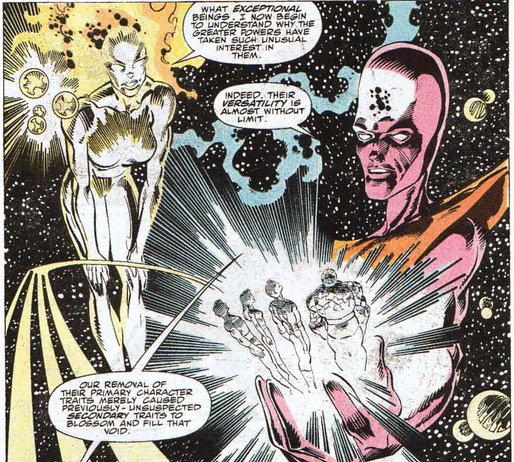
The next issue continues the New Marvel message that continuity is flexible. The title, subtitle and Dr Doom comments could come straight from a Marvel editor, weary of continuity, who just wants freedom for characters in shiny costumes to hit people without worrying over the details.

The genius of Walt Simonson
Incidentally, this is not a negative reflection on Walt Simonson:
he did what he could with the tools he was given, and probably
nobody could have done better. FF352 is an example of Simonson's
genius: a ground breaking idea that nobody has been able to
duplicate, a story that can be read either page by page or by
following the time jumps. And to underline his genius one of the
time jumps takes us back two issues: few people noticed at the
time, but the cover to FF350 shows a time stamp "12:33am": the
image shows an explosion, indicating that Reed escaped his trap in
FF350 because Reed deflected Doom's shot from 12:33 in FF352! See
Bully's blog for full details.
Simonson's final arc is a parody of what Marvel had become: a Time Variance Authority that interfered in tiny areas but was unable to have any lasting effect or see the bigger picture. it was all done in good humor: every middle manager in the TVA was a clone of Mark Gruenwald, Marvel's resident continuity expert.
"[The TVA was] a satire of where I thought Marvel was going at the time. They were becoming more corporate, more of an organization. ... [The TVA] were in some kind of null time zone. They had oodles and oodles of desk jockeys... There's no upper management."
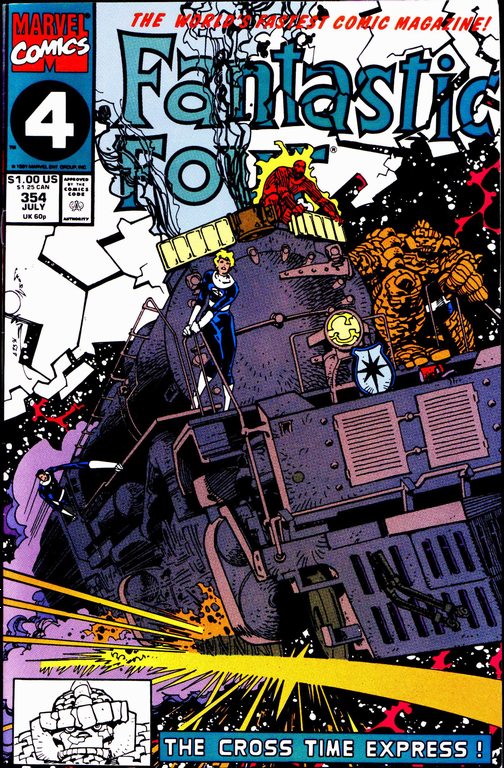

To make the metaphor complete - leaving behind the old Fantastic Four - they remove their clothes and leave them behind. We're starting afresh, entering a new and sexy era! The new FF could be compared to pornography: it tries to take all the most exciting parts of the real thing, but without the deeper relationship that gives the actions meaning.

Just like Englehart and Pollard, Simonson didn't like the new
direction, and left Marvel.
"I kinda like having a long-range story idea. .... I found very quickly that I kept having to alter my stories in the midst of writing them. I'd have an issue out, be writing a new plot, and they'd say 'Oh, by the way, next issue Thor's out in space. You can't use him. The breaking point came because I put Reed and Sue in the Avengers... I got permission to do this six months in advance. I got to issue #300, where I was going to do a new team, and I was told right about then, "Oh, by the way, we're putting Reed and Sue back in the FF. You can use them for an issue, and that's it. End of Story. I was pretty annoyed. I'd been working up story lines with permission for months, and watched it eviscerated. So I thought, 'This just isn't working out. Whatever you have to have to write this book, I don't have it.'" ( - Simonson, in "Modern Masters")
Q. "Do you remember why you left the Fantastic Four?"A. "It wasn't anything specific to me personally. It was more the direction - editorially speaking - Marvel was going in at the time that I felt made it more difficult for me to do my best work." [Older guys were being "mothballed" in favor of new guys, which is normal, but it was done in a way he found to be abrupt and disrespectful.] "...the atmosphere at Marvel was becoming less enjoyable, the scope for good creative work was more limited. I just felt I'd be better served if I went someplace else where I could do work the way I thought it should be done." ( - Simonson, "Comics Creators on Fantastic Four" p.135)
"When I got off the Fantastic Four, I started looking for work outside of Marvel." ( - Simonson, in "Modern Masters")
What happens after FF355? After a quick filler issue we have "a
bold new era" of the FF under Tom DeFalco. And the very first
thing he does becomes the poster child for bad retcons: "Fooled
you! Alicia was Lyja, a Skrull all along!" Not since Bobby stepped
out of that shower in Dallas has a retcon been so universally
mocked. But hey, "it's only comics," so nobody cares. Now Johnny
will be single forever, Alicia will be the Thing's girlfriend
forever, Franklin will never grow up, and Reed and Sue will go
round in circles forever. The story will not progress until
Marvel's finances are so weak that a new writers can appear with a
clear vision and move the story forwards again. (See also how the Marvel Universe
ended.)
As if to emphasize that all of John Byrne's changes were reversed
from FF355, Byrne's head was placed on the wall in FF359. referred
to as "a hostile race" that was "conquered" and "exterminated."
While it was never officially confirmed that this was Byrne, this
was exactly his hairstyle and profile at the time.
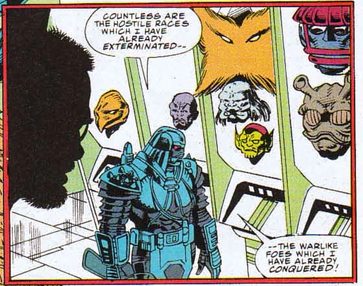
DeFalco is a really nice guy, his writing and Paul Ryan's art
were perfectly serviceable. Compared to the Image style that was
taking over, their work stands out as a beacon of clarity and
value for money. But continuity was ignored: if the past does not
matter why should the present? DeFalco's run is generally regarded
as the worst run ever, and DeFalco is routinely called "the Evil
One" (Comics Creators on Fantastic Four p.170). But here is the
irony:
But DeFalco and Macchio were just following the zeitgeist. The Fantastic Four is the story of America, and America had lost its direction. They merely reflected that.
This story has always had a life of its own, so these years of chaos and contradiction may be the most interesting period of all.The fall of the Marvel Universe by 1991 is documented here.
We now have a different Fantastic Four.
